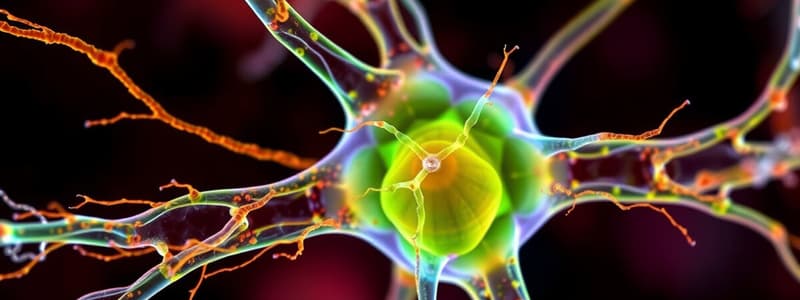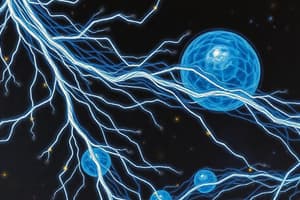Podcast
Questions and Answers
What is the primary structure of microtubules?
What is the primary structure of microtubules?
- Two chains forming a helix
- Flexible strands composed of actin and myosin
- Thick fibers made of various proteins
- Hollow tubes composed of α- and β-tubulin dimers (correct)
Which cytoskeletal component directly mediates cell motility through actin-myosin interactions?
Which cytoskeletal component directly mediates cell motility through actin-myosin interactions?
- Mitochondrial tracks
- Intermediate filaments
- Actin filaments (correct)
- Microtubules
What role do Rho-GTPases play in cellular motility?
What role do Rho-GTPases play in cellular motility?
- They promote the disassembly of focal adhesions.
- They direct the orientation of actin fibers in the cytoskeleton.
- They are involved in the formation of actin filaments.
- They regulate adhesion and protrusion during migration. (correct)
What is the role of microtubules in relation to vesicular transport?
What is the role of microtubules in relation to vesicular transport?
Cellular polarity is crucial for which of the following processes?
Cellular polarity is crucial for which of the following processes?
Which mediator is involved in the polymerization of actin filaments?
Which mediator is involved in the polymerization of actin filaments?
What is the primary function of focal adhesions during cell migration?
What is the primary function of focal adhesions during cell migration?
What distinguishes intermediate filaments from actin filaments and microtubules in terms of cell motility?
What distinguishes intermediate filaments from actin filaments and microtubules in terms of cell motility?
Which of the following best describes the role of protrusions in cell motility?
Which of the following best describes the role of protrusions in cell motility?
Which of the following options directly influences the assembly of microtubules?
Which of the following options directly influences the assembly of microtubules?
What effect does tension have on focal adhesions?
What effect does tension have on focal adhesions?
In terms of cell structure support, which of the following accurately describes the function of actin filaments?
In terms of cell structure support, which of the following accurately describes the function of actin filaments?
Which of the following is NOT a known role of microtubules?
Which of the following is NOT a known role of microtubules?
What contributes to the increased variation in microtubule behavior when utilizing tubulin isoforms?
What contributes to the increased variation in microtubule behavior when utilizing tubulin isoforms?
What is the primary structural unit of microtubules?
What is the primary structural unit of microtubules?
How do post-translational modifications (PTMs) influence microtubules?
How do post-translational modifications (PTMs) influence microtubules?
Which factor is NOT associated with the dynamics of tubulin isoforms?
Which factor is NOT associated with the dynamics of tubulin isoforms?
What structural arrangement is caracteristic of stress fibers in cells?
What structural arrangement is caracteristic of stress fibers in cells?
Which type of microtubule organization is typically found in dividing cells?
Which type of microtubule organization is typically found in dividing cells?
What is the main function of the cortical networks generated by actin structures?
What is the main function of the cortical networks generated by actin structures?
What consequence can mutations in TubB isoforms have?
What consequence can mutations in TubB isoforms have?
Which statement about the role of actin in generating cell geometry is correct?
Which statement about the role of actin in generating cell geometry is correct?
What feature distinguishes non-radial arrays of microtubules?
What feature distinguishes non-radial arrays of microtubules?
What is the primary function of stress fibers in elongated cells?
What is the primary function of stress fibers in elongated cells?
Which components are primarily responsible for generating contractile forces in cells?
Which components are primarily responsible for generating contractile forces in cells?
How does the actin cortex contribute to cell behavior during migration?
How does the actin cortex contribute to cell behavior during migration?
What structural role do actin and myosin play in morphogenesis?
What structural role do actin and myosin play in morphogenesis?
Which of the following best describes a lamellipodium?
Which of the following best describes a lamellipodium?
What is the function of filopodia in cell migration?
What is the function of filopodia in cell migration?
Where does the remodeling of tissue primarily occur in epithelial elongation?
Where does the remodeling of tissue primarily occur in epithelial elongation?
What is the primary role of a uropod in migrating cells?
What is the primary role of a uropod in migrating cells?
Which cellular projection is characterized by tightly bundled actin filaments?
Which cellular projection is characterized by tightly bundled actin filaments?
What defines the primary function of microtubules in epithelial morphogenesis?
What defines the primary function of microtubules in epithelial morphogenesis?
What is the primary role of podosomes in cells?
What is the primary role of podosomes in cells?
Which cellular structures are primarily responsible for increasing surface area for absorption?
Which cellular structures are primarily responsible for increasing surface area for absorption?
What initiates the nucleation of actin filaments during cell migration?
What initiates the nucleation of actin filaments during cell migration?
During mesenchymal migration, what occurs immediately after actin nucleation?
During mesenchymal migration, what occurs immediately after actin nucleation?
Which statement accurately describes the role of stress fibers in cell movement?
Which statement accurately describes the role of stress fibers in cell movement?
What is a key feature of lamellipodia during cell migration?
What is a key feature of lamellipodia during cell migration?
What occurs during the final stages of cell migration?
What occurs during the final stages of cell migration?
How do protrusions like lamellipodia and filopodia drive cell migration?
How do protrusions like lamellipodia and filopodia drive cell migration?
Which process involved in the formation of cellular protrusions is crucial for rearranging components?
Which process involved in the formation of cellular protrusions is crucial for rearranging components?
What type of actin structure is primarily associated with cell adhesion during migration?
What type of actin structure is primarily associated with cell adhesion during migration?
Study Notes
Cytoskeleton Overview
- Composed of three main components: Microtubules, Actin filaments, and Intermediate filaments.
- Provides rigidity, flexibility, shape, and structural support to the cell.
- Plays a critical role in cell movement, migration, division, and organizational reformation.
Comparison of Cytoskeletal Elements
Structure
- Actin Filaments: Composed of two chains in a helical structure, predominantly made of actin and myosin.
- Microtubules: Hollow structures formed from α- and β-tubulin dimers, typically anchored at the centrosome.
- Intermediate Filaments: Diverse, thick structures made of various proteins (keratins, vimentin), lacking inherent polarity.
Role in Cell Shape and Organization
- Actin Filaments: Provide mechanical support, maintain cell shape, and are involved in muscle contraction and cell division (cytokinesis).
- Microtubules: Organize internal cell structure, position organelles, and form mitotic spindle during division. Essential for vesicular transport.
- Intermediate Filaments: Provide tensile strength and reinforce cell shape.
Role in Cell Motility and Migration
- Actin Filaments: Form lamellipodia and filopodia, critical for cell movement and shape changes through actin-myosin interactions.
- Microtubules: Facilitate vesicular trafficking and centrosome positioning. Integral to cilia and flagella for cell motility.
- Intermediate Filaments: Do not contribute directly to motility but maintain organelle positioning and structural integrity.
Mechanisms of Assembly
- Actin Filaments: Assembly is ATP-dependent; involves nucleation and branching, with actin hydrolysis leading to fiber shortening.
- Microtubules: GTP-dependent assembly; GTP binding promotes growth, hydrolysis releases dimers.
- Intermediate Filaments: Assembly mechanisms are diverse due to varied protein compositions.
Mediators of Assembly
- Actin Filaments: Nucleation is mediated by ARP2/3 complex and NPFs.
- Microtubules: Assembly guided by isoform patterns of tubulin.
Variation in Microtubule Heterodimers
- Multiple Tubulin Isoforms: Various gene-encoded isoforms of α- and β-tubulin influence microtubule function.
- Post-translational Modifications (PTMs): PTMs enhance protein diversity and regulate behavior, affecting stability and interactions.
- Mutations: Alterations can impact growth, stability, and lead to tubulinopathies.
Actin Arrangements and Cell Geometry
- Microtubule Organization: Varies by cell type; cells can possess radial or non-radial arrangements influencing internal structure and dynamics.
- Actin Structures:
- Branched and Bundled Actin: Provide compressive resistance and protrusive forces.
- Cortical Networks: Generate tension in multiple directions, maintaining cell integrity.
- Stress Fibers: Contractile bundles that contribute to rigidity and migration by connecting to focal adhesions, utilizing actin-myosin interactions.
Steps in Formation of Cell Protrusions
- Cell Migration Steps:
- Signal pathway activation followed by actin nucleation.
- Establish cell polarity and frontal protrusions (e.g., lamellipodium).
- Form focal adhesions that generate forces necessary for cell movement and retraction.
Key Features of Protrusions, Polarity, and Focal Adhesions
- Protrusions: Actin-driven extensions (lamellipodia and filopodia) facilitate migration and environmental interaction.
- Cellular Polarity: Directs cytoskeletal organization, ensuring directional migration.
- Focal Adhesions: Multi-protein complexes linking the cytoskeleton to the extracellular matrix, vital for anchoring and transmitting mechanical signals.
Cytoskeletal Cross-talk in Migration
- Forces of Migration:
- Polarization: Establishes directionality for movement.
- Protrusion: Initiates movement via actin polymerization.
- Adhesion: Provides traction through integrin-mediated attachment.
- Retraction: Facilitates forward movement by releasing adhesions at the rear.
Studying That Suits You
Use AI to generate personalized quizzes and flashcards to suit your learning preferences.
Related Documents
Description
This quiz explores the differences and similarities between actin filaments, microtubules, and intermediate filaments. You'll examine their structures, roles in cell shape, motility, assembly mechanisms, and the mediators involved in these processes. Perfect for understanding cell organization and function.




